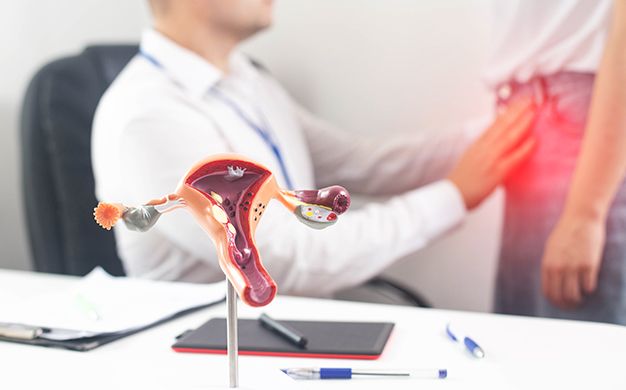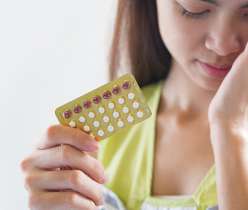Uterine fibroids are a common type of benign (noncancerous tumour) that can grow in and on your uterus.
Uterine fibroids are the most common benign pelvic tumours in women of reproductive age. According to research data, they affect 20 to 40% of those women but are found in 75% of hysterectomy specimens. This is due to most fibroids being asymptomatic (shows no symptoms). There are known risk factors for developing uterine fibroids, but the exact aetiology is still unknown. Not all fibroids cause symptoms, but when they do, symptoms can include back pain, heavy menstrual bleeding, frequent urination, and pain during intercourse. Fibroids most often occur in women during their childbearing years. The uterus is a pear-shaped organ located in the pelvic area. After a woman conceives, a baby grows and develops in the uterus. These fibroids in the uterus can develop as a single isolated growth or occur in a cluster. Sometimes, these lesions can appear as large as a watermelon. Fibroids range in size, are undetectable by the human eye and enlarge the uterus. In extreme cases, fibroids appear in clusters that can expand the uterus to the extent that it reaches the rib cage and can add weight. Get a prescription to buy women’s health medicines online to get them delivered to your doorstep.
Symptoms
Fibroid growth is common in the pelvis region. As per research studies, more than 50 per cent of women may develop fibroids. However, as mentioned above, these fibroids do not cause any symptoms in most women. Many women have uterine fibroids once in their lifetime. But most of them might not know they have fibroids in their uterus because they do not have any symptoms. Your doctor may detect fibroids in the uterus accidentally during a pelvic examination. In addition, for women who develop symptoms, their symptoms can be influenced by the size, location, and number of fibroids. In women who have signs associated with the uterine fibroids, the most commonly reported ones are:
- Heavy menstrual bleeding
- Menses lasting more than a week
- Pelvic pressure or pain
- Constipation
- backache or leg pains
- Frequent urination
- Trouble emptying the bladder
Rarely, a fibroid can cause acute pain when it grows too big and begins to die. There are several places inside and outside the uterus where fibroids can grow. Treatment usually depends on the size and location of the fibroids. Where the lesion appears, how big they are, whether they occur single or are multiple, all of this will determine which type of treatment will work best for you when the treatment is the only option left. Different names are termed for where your fibroids are located inside or outside the uterus.
- Intramuscular fibroids – Fibroids that grow within the muscular uterine wall.
- Submucosal fibroids – grow inside the uterine space where a baby grows and develops during pregnancy.
- Subserosal fibroids – are located outside the uterus and get stuck to the outside wall of the uterus.
You must see your doctor if you develop the following:
- Pelvic pain that doesn’t resolve
- Prolonged periods
- Sopping between periods
- Trouble emptying your bladder
- Anaemia (low red cell blood count)
Take immediate medical help if you have severe vaginal bleeding or sudden/sharp pelvic pain.
Causes
The exact cause of uterine fibroids is still unknown, but according to research studies, the following can be the reasons:
- Hormonal changes – Estrogen and progesterone are the two sex hormones responsible for developing the uterine lining during each menstrual cycle to support pregnancy appear to promote the growth of fibroids
- Genetic factors – genetics can contribute to the development of uterine fibroids, although genetics may not be the primary nor the singular cause. As per some research reports, fibroids bear some chromosomal abnormalities. Certain genes are responsible for the contribution of fibroid development.
- Other growth factors – Substances that help maintain the tissues, such as insulin-like growth factors, may affect the growth of fibroids.
- Extracellular matrix (ECM) – ECM makes cells adhere to each other exactly like mortar between bricks. The amount of ECM is high in fibroids which makes them fibrous. ECM also stores growth factors and is responsible for causing biological changes in the cell themselves.
Prevention & Treatment
Preventing uterine fibroids may not be possible, but only a small percentage of these benign tumours require treatment. If you are not experiencing any symptoms, you may not need treatment. It is important to monitor your fibroids over time closely, but there is no need to take immediate action. If you develop symptoms from your fibroids, including anaemia from moderate to severe pain, excess bleeding, bowel issues, urinary tract problems and infertility issues. Treatment is usually needed to help resolve the issues. In general, a treatment plan depends on a few factors, including:
- Number of fibroids
- Size of fibroids
- location
- symptoms you are experiencing
- Your desire for pregnancy
- Your desire for uterine preservation
Buy women’s multivitamins supplements online at the lowest price. The best treatment option will depend on your future fertility goals. If you wish to have children in the future, some treatment options may not be suitable for you. Therefore, it is important to talk to your doctor about your thoughts on fertility when taking treatment options. Treatments include:
- OTC medications – OTC to get rid of discomfort and pain caused by fibroids
- Iron supplements -To reduce excess bleeding in case of anaemia
- Birth control – These help with symptoms of fibroids, specifically heavy bleeding and menstrual cramps. Buy women’s health supplements online to improve your health
- Gonadotropin-releasing hormone (GnRH) agonists- These medications cause the fibroids to shrink and can be given via nasal spray or injection. They shrink a fibroid before surgery, making it easier to remove it. However, the treatment is temporary; if you stop it, the growth reappears
- Oral medications – Available to manage heavy uterine bleeding in case of perimenopause




